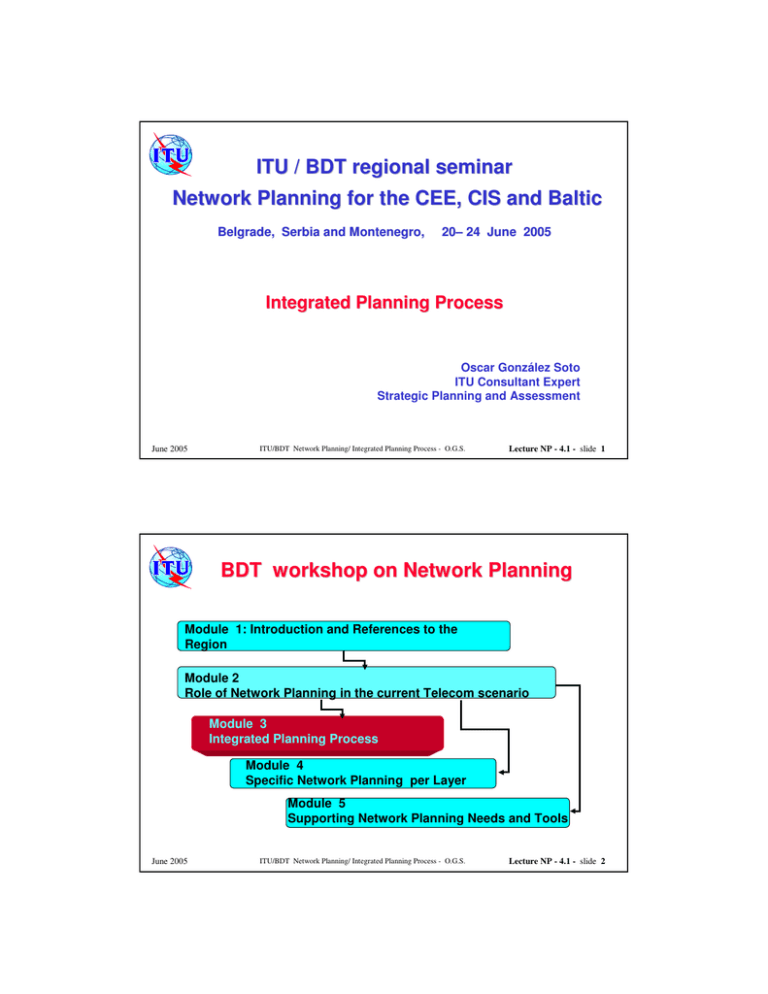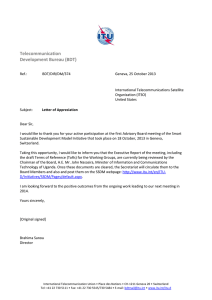ITU / BDT regional seminar Integrated Planning
advertisement

ITU / BDT regional seminar Network Planning for the CEE, CIS and Baltic Belgrade, Serbia and Montenegro, 20– 20– 24 June 2005 Integrated Planning Process Oscar González Soto ITU Consultant Expert Strategic Planning and Assessment June 2005 ITU/BDT Network Planning/ Integrated Planning Process - O.G.S. Lecture NP - 4.1 - slide 1 BDT workshop on Network Planning Module 1: Introduction and References to the Region Module 2 Role of Network Planning in the current Telecom scenario Module 3 Integrated Planning Process Module 4 Specific Network Planning per Layer Module 5 Supporting Network Planning Needs and Tools June 2005 ITU/BDT Network Planning/ Integrated Planning Process - O.G.S. Lecture NP - 4.1 - slide 2 Integrated Planning Process Content • Definiton of processes and interrelations • Network design tasks • Parameters and Data June 2005 to be used in the planning ITU/BDT Network Planning/ Integrated Planning Process - O.G.S. Lecture NP - 4.1 - slide 3 Integrated Planning Process Scope: Related Processes Business Planning Network Planning Strategic Network/business Planning Long Term Structural Planning Short/Medium Term Planning Network Network Support Processes Customer Care & Billing ... Network Traffic & QoS Measurement ... Management The Network June 2005 ITU/BDT Network Planning/ Integrated Planning Process - O.G.S. Lecture NP - 4.1 - slide 4 Integrated Planning Process Flows among Processes • Data on topologies, architectures, location, routing, etc from long term planning are transfered to the medium term and iteratively to short term activities • Planning results are transfered to NM applications and viceversa, NM measurements and status are provided as inputs to the planning activities • Operating System Processes also provide data to the short/medium term planning activities on the traffic demand, performance and Origin/destination flows June 2005 ITU/BDT Network Planning/ Integrated Planning Process - O.G.S. Lecture NP - 4.1 - slide 5 Planning Methodology: Integrated Iterative Planning Process Analysis of Initial Context Business Assessments Generation of Competitive Scenarios (Inputs) Traffic Demand Forecasting Network Design & Configuration Business & Financial Planning Technical and Economic Results (Outputs) Procedures and Tools June 2005 ITU/BDT Network Planning/ Integrated Planning Process - O.G.S. Lecture NP - 4.1 - slide 6 Integrated Planning Process Iterative sub-processes • Telecom network scenarios are generated with the premises derived from realistic competitive sitiation • Final objective is to have a quantified design fullfiling the strategy for the operator and the requirements of the society • Defined processes and tasks are needed for all solutions and technologies. Internal data and alghoritms vary for each case • Feedback among activities is needed to incorporate results of the optimization on the inputs and assumptions • Business assesment is made at the process start to select feasible solutions. More detailed business plan is obtained at the end June 2005 Lecture NP - 4.1 - slide 7 ITU/BDT Network Planning/ Integrated Planning Process - O.G.S. Integrated Planning Process Strategic view: Network Layer Modeling IP Voice Mail SMP SCP Service and Control level HLR/AuC TSC UMS e-applications TEX SSP WLL/Mobile Functional level VOD SSW SSP MSC BSC TVoDSL IN EIR BTS VoIP SMS-C Int’l POP/LEX Fixed NB/BB NGN network GW DATA/IP LL Transport/SDH/WDM Infrastructure and Cable level June 2005 ITU/BDT Network Planning/ Integrated Planning Process - O.G.S. Lecture NP - 4.1 - slide 8 Integrated Planning Process Multilayer planning sequence Network Layers Planning process Data flows Service and Control level NE dimensioning Delay evaluation Traffic Demand Functional level Circuit location/design Routing optimization BW grooming Transport/SDH Infrastructure and Cable level June 2005 ITU/BDT Network Planning/ Integrated Planning Process - O.G.S. Route design/optim. Path protection Physical Layout Cable routing/grouping Node/duct sharing Lecture NP - 4.1 - slide 9 Integrated Planning Process Task sequence • Starts with services and traffic demand projection • First design is made for the functional level: switching, routing, mobile, data, etc. • Intermediate results are given as inputs for Transmission and control layers • Transmission results are provided as inputs to the Physical layer • Iteration is made among layers and basically to the functional for consolidation June 2005 ITU/BDT Network Planning/ Integrated Planning Process - O.G.S. Lecture NP - 4.1 - slide 10 Integrated Planning Process The Functional Network Design Tasks Input data scenario Network coverage Input data network Service Demand Predefined Locations and NE Predefined Architecture (Blueprint) Network definition and design Traffic Matrices Solution Mapping and Architecture Selection Node & Link Dimensioning Performance Evaluation June 2005 ITU/BDT Network Planning/ Integrated Planning Process - O.G.S. Location Capacity Connectivity Network results Solution Cost Lecture NP - 4.1 - slide 11 Integrated Planning Process Input Data • Input categories • Geo-scenario • Customers, Services and traffic • Existing network • Technology characteristics and capacities • Performance • Economical June 2005 ITU/BDT Network Planning/ Integrated Planning Process - O.G.S. Lecture NP - 4.1 - slide 12 Integrated Planning Process Input data • Geo scenario • Number of differentiated service areas: (Metropolitan,Suburban,Villages, Rural) • Surface for each area • Distance to the core service area • Population per area (volume and density) • Number and distribution of households • Customer density and clustering • Digitalised maps (scales 1:5000 to 1:1000) • Regulatory rules • Interconnection locations and constraints June 2005 ITU/BDT Network Planning/ Integrated Planning Process - O.G.S. Lecture NP - 4.1 - slide 13 Integrated Planning Process Input data : Geo maps June 2005 ITU/BDT Network Planning/ Integrated Planning Process - O.G.S. Lecture NP - 4.1 - slide 14 Integrated Planning Process Input data • Customers, services and traffic (1) • Customer segments (as a function of degree of detail) - Residential (Low and High end) - SOHO - SME - Large institutions and corporations • Services - POTS, 64kb/s data, ISDN Basic/primary access - Leased Lines (64, n x 64, 2 Mb/s) - ADSL (high speed internet), HDSL, SDSL - IP mode - Video - FO, SDH, Managed bandwidth June 2005 ITU/BDT Network Planning/ Integrated Planning Process - O.G.S. Lecture NP - 4.1 - slide 15 Integrated Planning Process Input data • Customers, services and traffic (2) • Traffic (per customer class and service type) - Customer calling rate - Erlangs per customer - IN messages per call - IP sessions per customer - Average Packet and Bit rates per IP mode flow and/or customer (PCR and SCR) - NM and control messages/packet rate June 2005 ITU/BDT Network Planning/ Integrated Planning Process - O.G.S. Lecture NP - 4.1 - slide 16 Integrated Planning Process Input data • Technology related: • Physical elements sizes (cabinets, racks, boards, etc.) • Capacity per main NE: - Switches, routers, ADM, CxC and RSU - Processors (Packet Rate, Message Rate, etc.) - Memory - Channels ( max bandwidth and guaranteed) • Routing types • Load sharing rules • Performance parameters (Availability, QoS, etc.) June 2005 ITU/BDT Network Planning/ Integrated Planning Process - O.G.S. Lecture NP - 4.1 - slide 17 Integrated Planning Process Input data • Existing network: • Existing node locations, sizes and service areas • Existing link locations and capacities • Existing cable maps, capacities and spares • Existing NE locations, capacity and filling degree • Building locations, capacities and conditioning • % reusability of civil infrastructure in primary over all area • % reusability of civil infrastructure in secondary over all area June 2005 ITU/BDT Network Planning/ Integrated Planning Process - O.G.S. Lecture NP - 4.1 - slide 18 Integrated Planning Process Input data • Performance • Waiting lists per customer type • Call completion rates (overall, per type and per O/D) • QOS ( Loss probability, Node and End to end Delays, etc.) • Availability (MTBF, MTTR, etc.) in overall and per cause: power, HW, SW, etc. • Bit error rate June 2005 ITU/BDT Network Planning/ Integrated Planning Process - O.G.S. Lecture NP - 4.1 - slide 19 Integrated Planning Process Input data • Economical • Generic (for all technologies) - Macroeconomic data (GDP, etc.) - Interest rates - Exchange rates • Reference costs (per solution) - NE costs for typical economy of scale (minimum configuration and incremental per modularity) - Civil works and labor-force - Engineering, installation, testing and commissioning - Operational and Maintenance resources - Interconnection - Marketing and overheads June 2005 ITU/BDT Network Planning/ Integrated Planning Process - O.G.S. Lecture NP - 4.1 - slide 20
